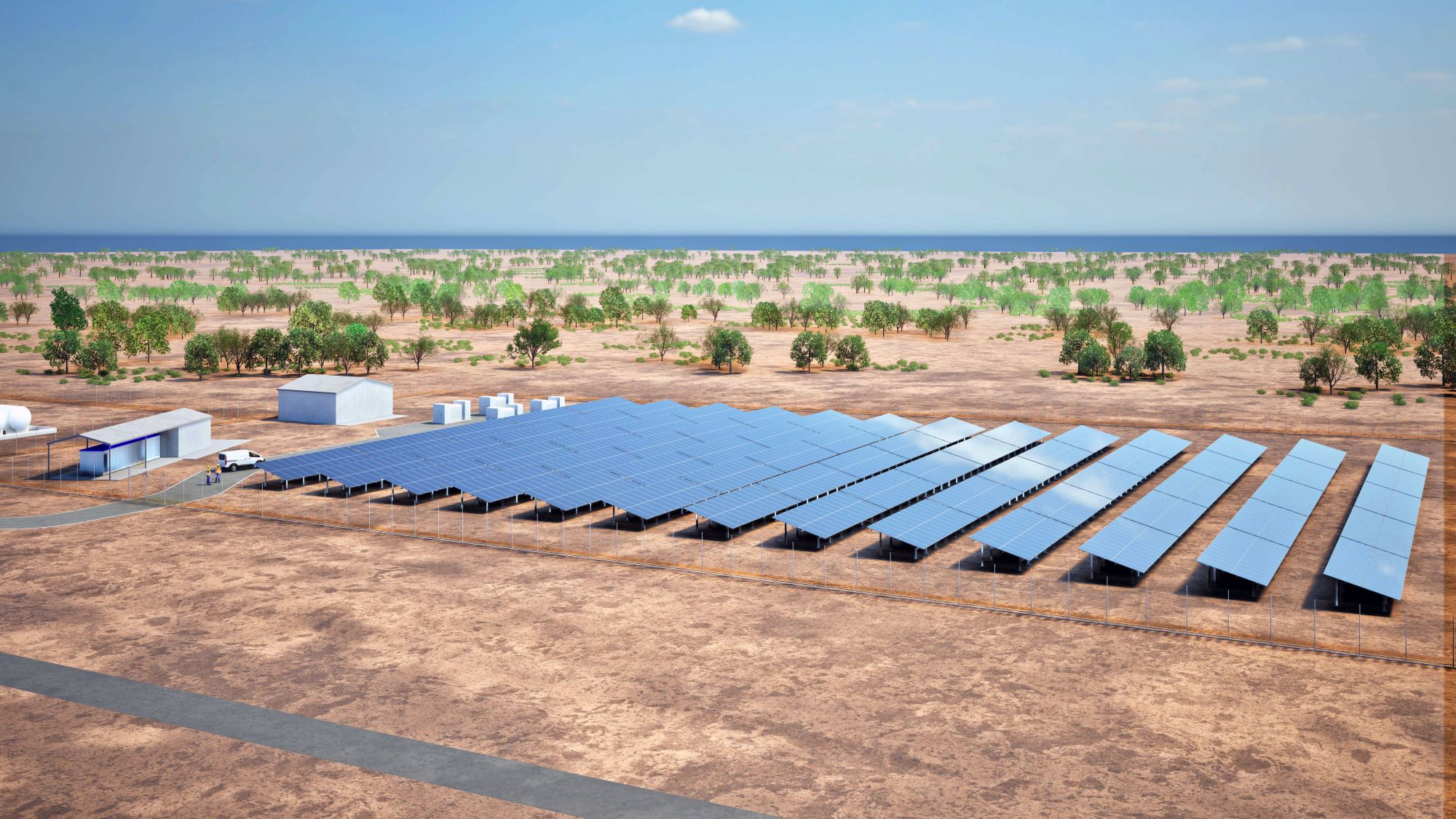
Artist’s impression of new Windorah solar farm
Windorah is a small, isolated outback community located in central west Queensland. Windorah has a population of around 100, most of whom live in the township, with the remainder living and working on cattle and sheep stations in the surrounding district.
The town’s electricity has historically, and is currently, supplied via an isolated network - or microgrid - powered by diesel generation at the local power station, located on the outskirts of town.
While they have served the energy needs of the local community for some time, diesel generation presents several financial and environmental challenges, so we’re building a new solar farm and battery energy storage system (BESS) at Windorah.
With funding from the Queensland Government, Ergon is building a new, modern solar farm and BESS facility at Windorah. The project will use the latest technology to help to reduce our reliance on diesel generation, and to help to transition the town’s energy supply to cleaner, greener renewable energy.
The first stage of the solar farm will see 850 kilowatts of solar PV built – enough to power around 50% of Windorah’s total energy needs on the same sized site as the previous solar trackers. As well, 1000 kilowatt hours of energy storage will be built at the power station, to store excess energy for use after the sun goes down.
This initial phase of the Windorah solar farm and battery project will significantly reduce diesel emissions and is anticipated to save around 150,000 litres of diesel and $300,000 each year.
And, while it’s not planned for some time yet, the next stage of decarbonising the Windorah isolated network will see us aiming to supply 100% of the town’s electricity needs with renewable energy.
To find out more about the Windorah community, and its isolated electricity network, read our Windorah community profile (PDF 621.9 kb), our project updates below, our Frequently Asked Questions (PDF 1.5 mb) and watch the video below.
Hi I'm Andrew, and I'm here at the Windorah Power Station, where with some funding support from the Queensland government, we're building a new solar farm and battery.
The new facility will be built on the same site as the old solar concentrators right next to me here at the Windorah power station. The new system will consist of around 850 KW of solar and have 1 1/2 megawatt hours of battery storage.
The system will generate enough electricity to supply around 75% of the town's power needs. And because it will harness the sun's energy to create electricity, we estimate it will reduce the amount of diesel used to power the town by about 200,000 litres a year. So it's also great for the environment.
It's all part of our plan to reduce our reliance on fossil fuels and to decarbonize our isolated networks.
If you want to know more about the Windorah project, or our broader plans to decarbonize our isolated networks, you can check out our website.
In this video, senior isolated network project engineer Andrew Kunst explains what's on the horizon to power the outback Queensland community of Windorah.
You can keep up to date and provide feedback on the latest project activities through the following information.
Download the newsletters to find out more.
Subscribe for updates and select ‘Windorah solar farm & battery' in the Major Project drop down list. And you can add in ‘Keep me updated’ in the Your Feedback section.
Any personal information we collect about you will only be used and disclosed by us in accordance with our Privacy Statement.

Artist’s impression of new Windorah solar farm
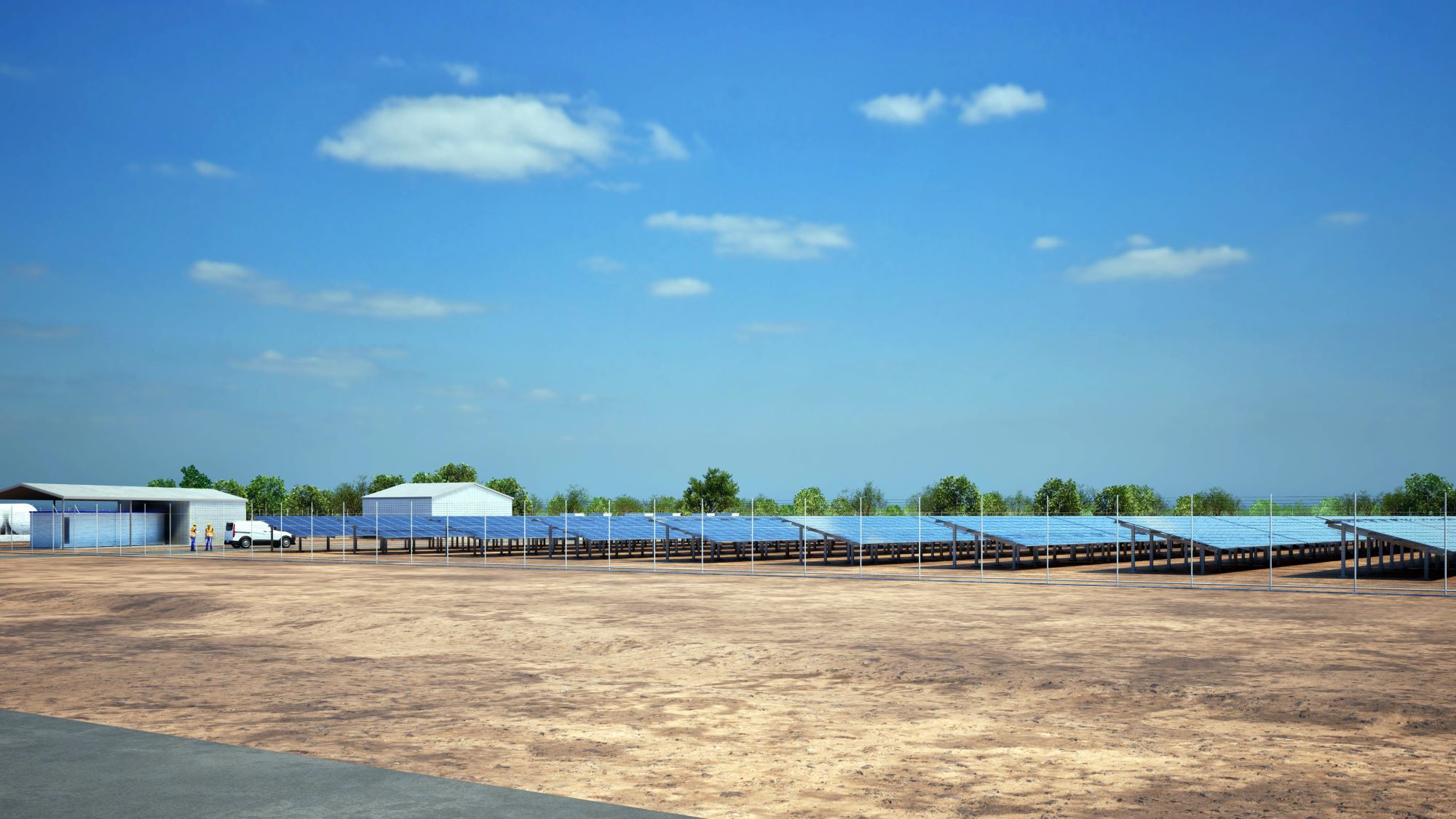
Artist’s impression of new Windorah solar farm
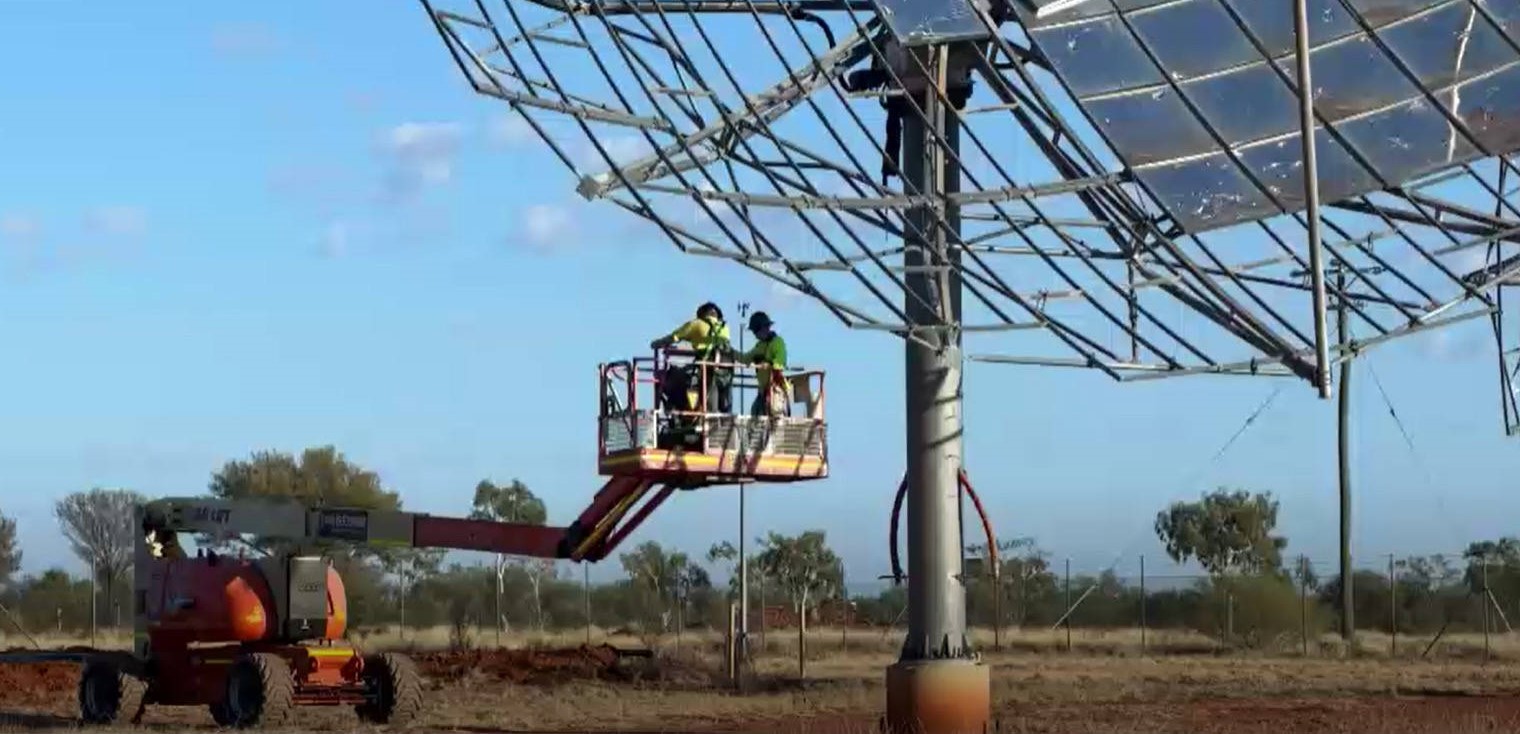
Decommission of the Windorah solar trackers
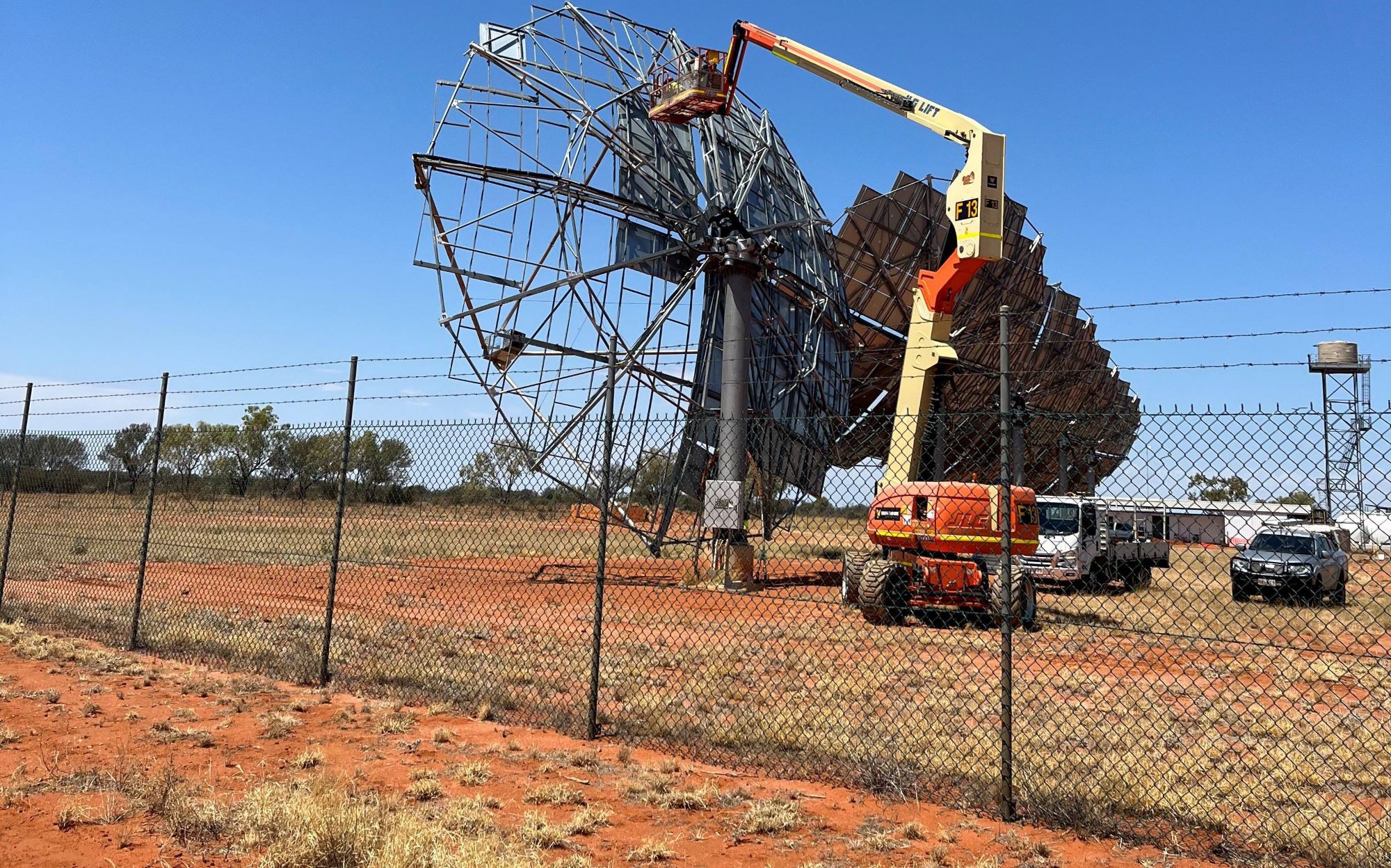
Decommission of the Windorah solar trackers
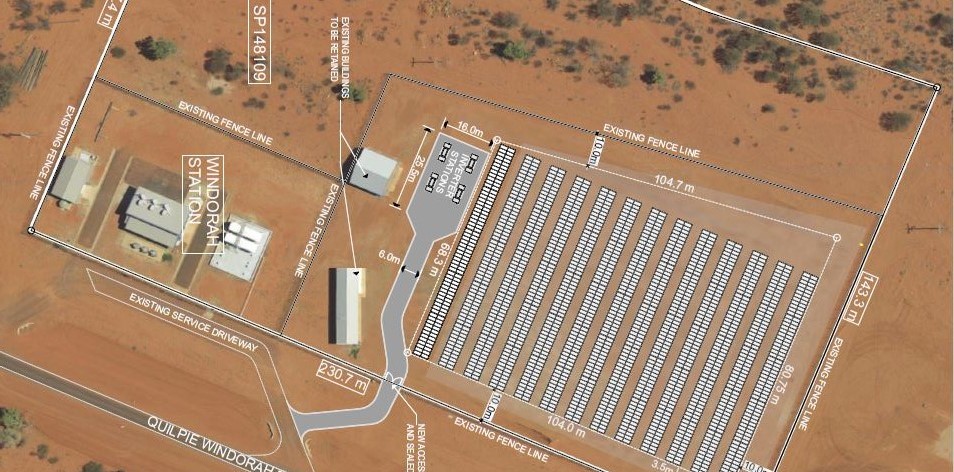
New Windorah solar farm proposed site layout
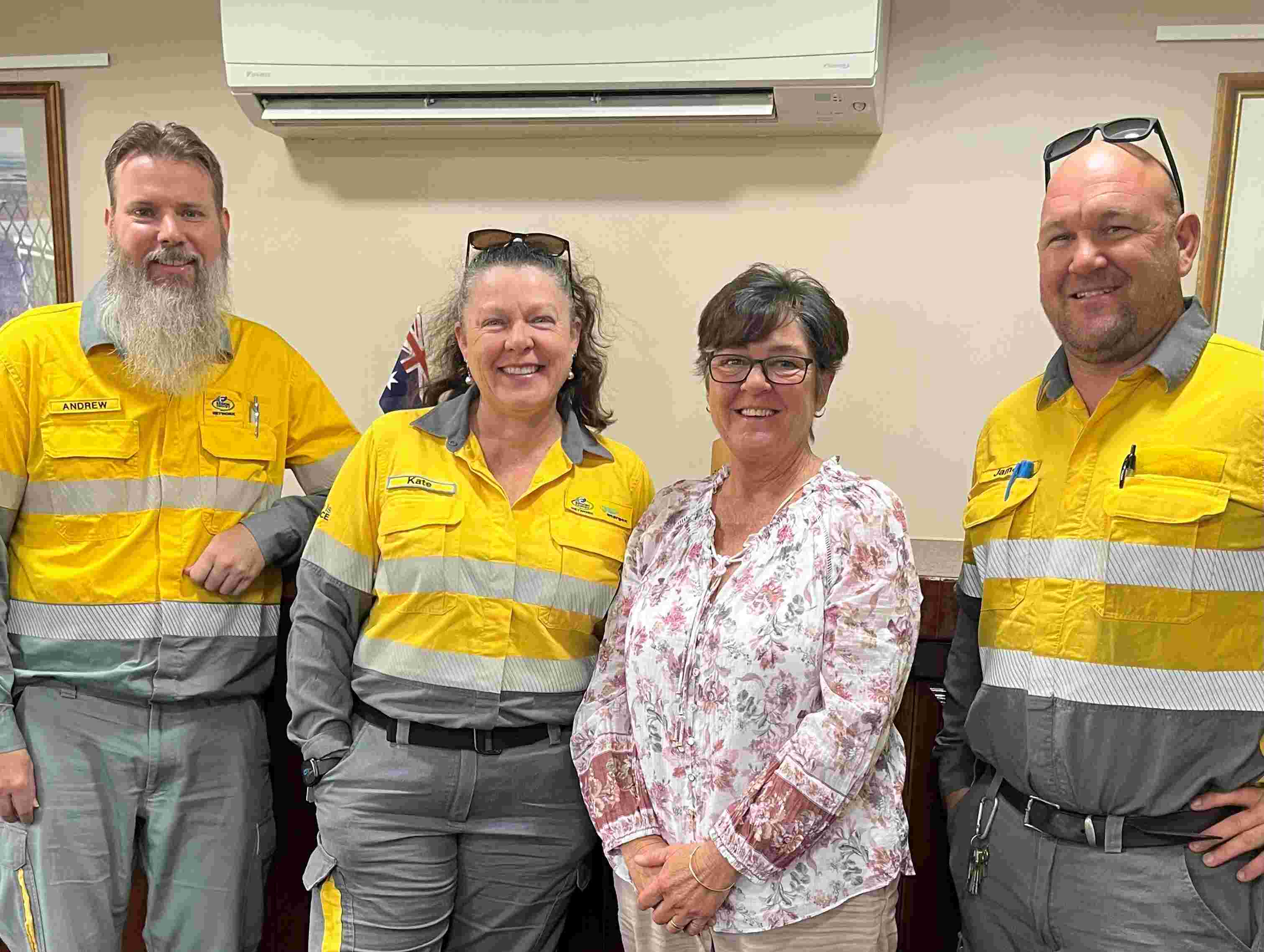
Engaging with Barcoo Shire Council Mayor Sally O’Neil
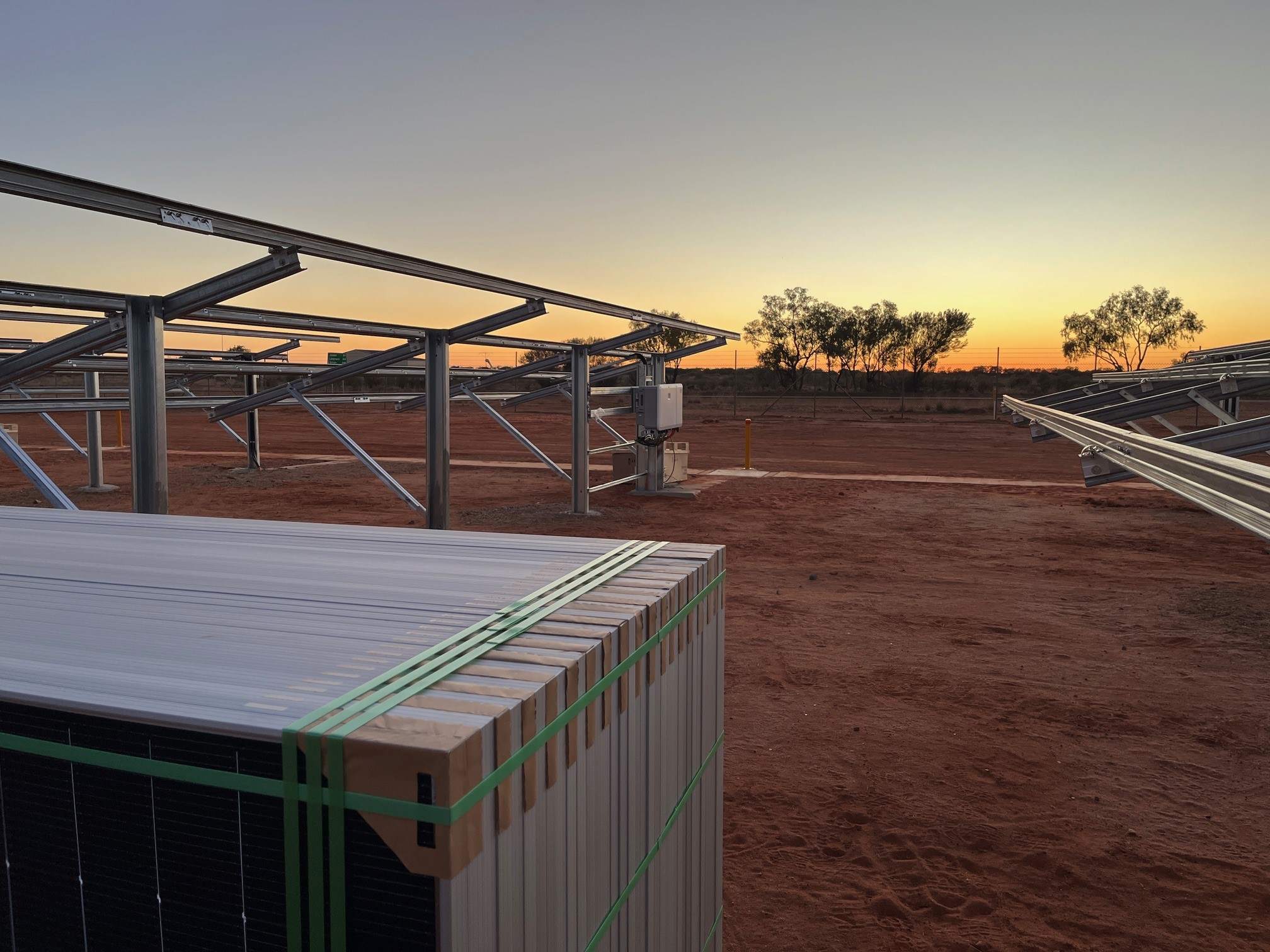
Solar array racks are ready for the solar panels to be installed
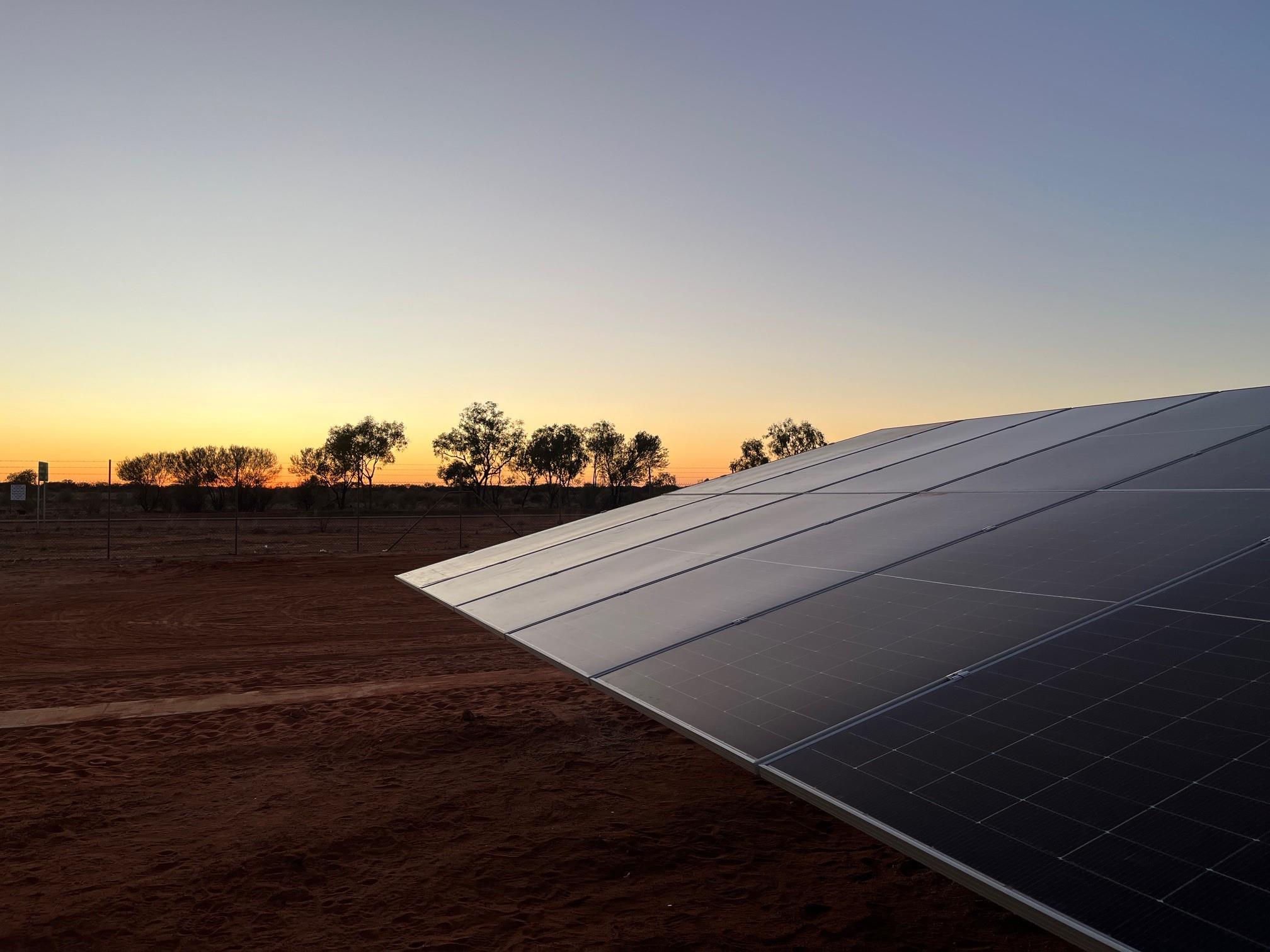
The first of the solar panels are installed
Windorah’s electricity network is an isolated network, so it’s similar to a microgrid.
A microgrid is a small-scale electricity network, powered by one, or many distributed energy resources, like solar PV, wind, and diesel.
With advances in technology, they are increasingly intelligent energy systems, designed to be self-sufficient and to power the electricity needs of a discrete group of customers, or small community like Windorah.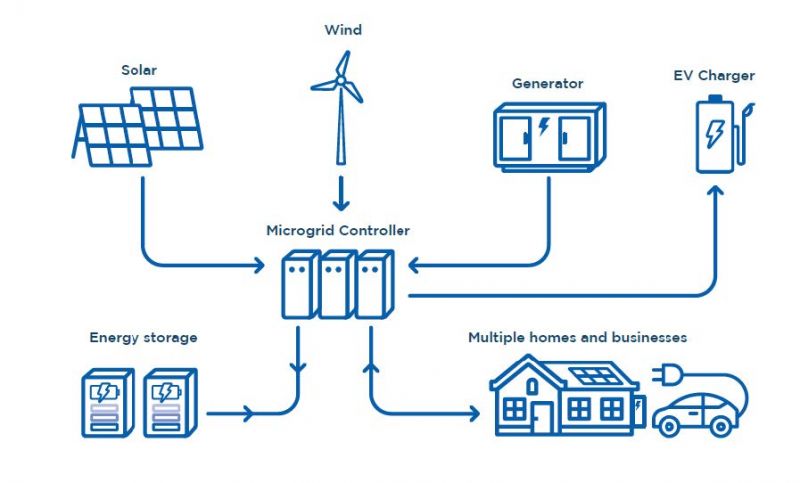
Microgrids can be operated either connected to, or stand alone, from the main electricity network. Windorah’s isolated network is a standalone microgrid, not connected to the main electricity grid.
We are always looking for ways to modernise and future-proof our isolated electricity networks, so that we can reduce costs and the reliance on fossil fuels. Our isolated networks, like the one at Windorah, were originally designed based on the available technology of the day - diesel generators. Diesel generation presents challenges in that they produce high levels of emissions when the diesel is burned, and they require a minimum level of electricity load to function properly.
And now, increasingly our customers are wanting to install their own solar PV on homes and businesses, which, if not managed correctly, can affect network stability.
We support our customers choice to install solar, so we need innovative solutions to support this take-up and still maintain network reliability, as well as reducing the amount of electricity produced from diesel.
With the advances in technology over the past decade or so, we can build a new solar farm and battery at Windorah that produces reliable power for the community, reduces cost and emissions and limits our impact on the environment.
Like the Windorah community, we were very proud of the original Windorah Solar Farm. When it was commissioned as a trial back in 2008, it was a first for the State of Queensland, and Ergon Energy Network. The solar concentrators were considered state of the art technology at the time, and although they were an iconic site on the Windorah horizon, over time, the technology became outdated, and no longer met the electricity needs of the community.
As time has passed, the old trackers had started to show signs of deterioration. To leave them in place would have introduced significant maintenance costs, and possibly see them deteriorate into an unsafe state. Dismantling and recycling the concentrators has paved the way for us to build Windorah’s new solar and battery farm on the same location.
But we won’t forget the importance of the solar trackers, both as an iconic symbol of the Windorah community and to advance our transition of our isolated networks to more sustainable energy solutions. Once the new solar and battery farm is built, we will commission some signage to commemorate the solar concentrator dishes and provide information about Windorah’s new solar and battery farm.
BESS stands for Battery Energy Storage System but are commonly just called batteries.
They are a type of energy storage system that uses batteries to store excess energy for use later.
They come in various shapes and sizes, and they can use different technologies. They are essentially a rechargeable battery that can store excess energy, often from renewable energy sources like solar PV, that can be used later when it’s needed, like at night when everyone comes home and turns on their air conditioners and cook dinner.
They also help with smoothing the power output when the solar system is intermittent, like when a cloud passes over.
They play an important role in making renewable energy more readily available, for instance, not just when the sun is shining.
Windorah’s new solar farm and battery will be located on the same site as the original Windorah Solar Farm on Quilpie Windorah Road. The new solar arrays will be built within the same footprint as the old solar tracking dishes. The battery will be located near the arrays. The site is adjacent to the current diesel power station.

The new Windorah solar farm will comprise of approximately thirteen rows solar panels, attached to a ground mounted, fixed tilt solar panel racking system – see the artist impression images of the site below. The panels will be mounted on the frames, tilted at an angle of about 15° to maximise the collection of solar energy. The arrays will run roughly parallel to Quilpie Windorah Road, facing towards the north-east.
The batteries will be located on the same site, on a cleared area adjacent to the arrays. They will comprise of a series of enclosed cabinets, like large refrigerators or small containers. The batteries can be seen in the below artist impression behind the solar array.
The existing buildings on the site will be retained and repurposed, and the site will be fully fenced for security.
This initial phase of the project – installing the 850 kilowatts of solar PV and 1000kWh of battery storage - will involve several elements, delivered in stages.
To prepare the site for the new solar farm, some early works have been undertaken towards the end of 2024 to decommission the solar concentrators from Windorah's first solar farm. The solar trackers have been decommissioned, dismantled and recycled, and the site has been cleared so that civil works for the new solar farm can commence.
The first stage of the new solar and battery farm project is to go out to tender for the contractor who will construct the new solar and battery farm. Tender applications will be reviewed and assessed, and the successful tenderer awarded the contact.
This stage commenced in December 2023 and is now complete.
Stage 2 of the project will see our Isolated Systems Team finalise the design of the new Windorah Solar Farm. The new solar farm will then start to take shape on the ground as the successful contractor completes the civil and electrical construction to build the new solar farm.
This stage commenced in August 2024 and is scheduled to be completed in February 2025.
Stage 3 will involve the design and construction of the batteries and inverts. During the design phase the team will design how Windorah's solar, batteries and diesel generator interact into a single integrated system.
Stage 3 commenced in August 2024 and is planned to be completed by July 2025.
The fourth and final stage of the project is system integration and commissioning. During this stage, our technical experts will test the system to ensure all aspects of the intelligent microgrid system are integrated and operating properly. They will conduct a range of tests to ensure safe operations and performance before commissioning the system to power the Windorah community.
This final stage of the project will run from May to December 2025.
Our community engagement involves getting to know the Windorah community. We'll undertake a range of engagement activities including, sitting down with the Council, Windorah Development Board and the community, to explain the project, introducing some energy literacy education, and working together on some of the operations for the project. We'll also be creating new site signage for the new Windorah solar and battery farm.
The project started in August 2023, when we secured funding from the Queensland Government for the project and established our small project team.
Decommissioning Windorah’s old solar concentrators and levelling the site in preparation for the new solar farm and battery construction was carried out in late 2023.
The project will be delivered in stages and will be completed by the end of 2025.
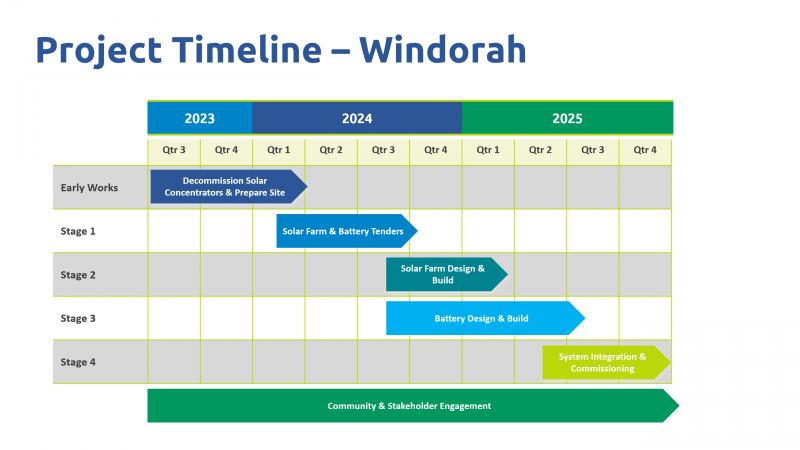
No, you won’t see changes to how electricity is supplied to you, or to your power bill. When the project is completed and the solar farm and battery is operational, you might notice that the generator at the power station isn’t running as much, and it’s a little quieter.
Construction projects can be disruptive to the community and the Windorah Solar Farm and Battery may present some impacts. Impacts typically associated with the construction of a project like this include:
There will also be positive impacts associated with the project including:
We anticipate the impacts associated with the construction of the Windorah Solar Farm and Battery will be very minor, and the project team will continue to keep the community and key stakeholders updated throughout the project.
Yes – Ergon Energy Network will own the solar array, the battery energy storage systems at our diesel power station and existing network assets.
Energising communities not connected to the National Electricity Market can be a challenge. Traditionally, the most reliable method of keeping the lights on was using diesel generators.
With new developments in technology, we can reduce carbon emissions intensity and the cost of producing electricity. These new technologies will allow us to power isolated networks with clean, renewable sources of energy long into the future.
This phase of the new Windorah Solar and Battery Farm project will significantly reduce diesel emissions and is anticipated to save around 150,000 litres of diesel and $300,000 each year.
It will contribute towards the Queensland Government’s 70% by 2032 renewable energy target, and the state’s journey to net zero emissions by 2050.
The battery will be installed and maintained to the same high standard we would for any of our other electricity network assets. The operational practices for the batteries in the trial will also minimise the safety risks.
All chemical or energy infrastructure in the community, whether a petrol station or other electricity infrastructure, have some risks.
To address this, we will use the latest technology batteries, and they will be built in a cleared area in the Windorah power station grounds, well away from town. They will also be monitored remotely 24/7.
The likelihood of an incident is very low, however in the unlikely event the batteries’ alarms are triggered, we will have protocols in place to respond. Prior to commissioning the batteries, we will engage with the local Rural Fire Brigade and other Emergency Services and have an appropriate Emergency Management Plan established.
The Lithium-ion batteries we are using are expected to have a minimum life of 10 years, depending on how they are operated. They could have a life of up to 15 years.
Yes, they are already being recycled. We have already engaged with an Australian recycling company.
We expect to review what is best practice, and our preferred recycler or recyclers, as our investment in battery technology begins to scale up.
We expect recycling services to evolve, potentially with economic opportunities for Queensland, as electric vehicle batteries drive demand for these services.
Europe is introducing new rules requiring greener batteries with lower associated emissions, and recycled materials. This circular economy legislation, which covers the entire lifecycle of a product, will drive innovation in battery recycling world-wide.
The battery system has inverters, which are electronic devices that transform the direct current (DC) energy discharged by the batteries, to alternating current (AC) electricity which is used in our homes and businesses. Although there is some noise emitted from the inverter units, the solar farm and battery site is almost 1km out of town, adjacent to the existing diesel generators, so it’s unlikely the community will hear noise from the batteries.
When new electrical infrastructure projects, like the Windorah solar farm and battery are discussed, many people ask about electric and magnetic fields (EMF). EMF are generated by any object with electric current flowing through it, including powerlines and all electrical appliances used in homes such as televisions, washing machines, microwaves, hair dryers and computers.
The level of EMF from the batteries will depend on the amount of current and the fields decrease in strength the further you move away from the source.
All the equipment Ergon uses and installs onto our network must comply with strict industry standards and our standards for EMF emissions continue to be better than those required by Australian and international health authorities.
We’ve got more detailed information on EMF and links to other relevant organisations on our Electric and magnetic fields web page.
Download a copy of the Frequently Asked Questions (PDF 1.5 mb) for the Windorah solar farm and battery project.
We aim to provide the community with balanced and objective information to help in understanding the need for this project, our delivery approach and how it may affect people.
We'll keep the local community informed, and we’ll acknowledge and consider any feedback.
We'll provide information in different ways including:
For more information or to provide us with feedback, please contact the project team:
Online: Project feedback form
Email: NetworkProjectEngagement@energyq.com.au
Phone: 1300 653 055